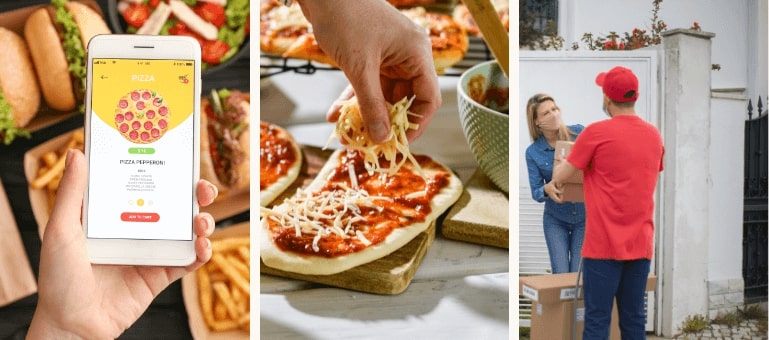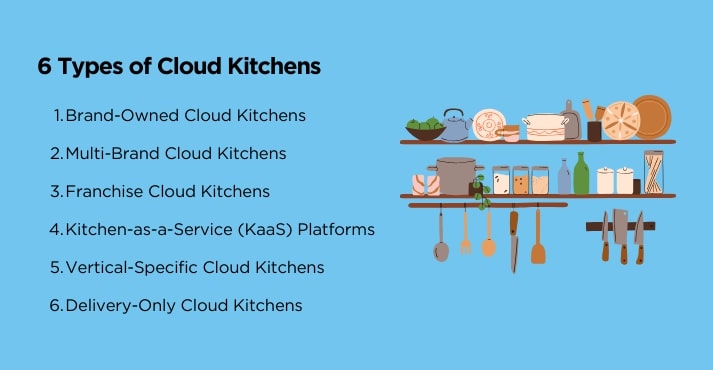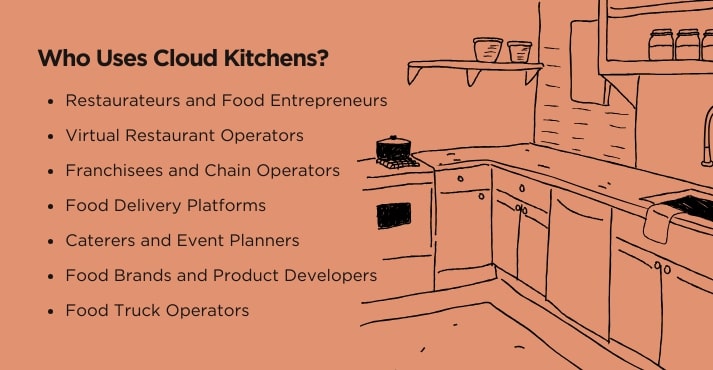Have you ever wondered about the latest revolution in the food industry? Well, allow us to introduce you to the fascinating concept of cloud kitchens! These innovative virtual kitchens are rapidly gaining popularity and transforming the way we experience food.
How does it all work? It’s quite intriguing! Leveraging advanced technology and online platforms, these virtual kitchens receive orders, whip up delectable meals, and deliver them directly to your doorstep.
Say goodbye to long waiting times and hello to the ease and convenience of enjoying restaurant-quality meals in the comfort of your home.
Throughout this enticing journey, we’ll uncover the secrets behind cloud kitchens’ rising popularity in the food industry and explore how they’re reshaping the culinary landscape. What is a Cloud Kitchen?
Defining the Cloud Kitchen Concept
Let’s take a closer look at what exactly a cloud kitchen is. It’s a cutting-edge concept that has revolutionized the food industry – a delivery-only restaurant where culinary magic happens in a centralized kitchen, with no physical dine-in option in sight.
Cloud kitchens are like virtual restaurants, dedicated solely to preparing and cooking delicious dishes for delivery and takeout.
The heart of their operation lies in a centralized kitchen where skilled chefs work their culinary wonders, crafting delectable meals ready to savor by hungry customers.
So, why the name “cloud kitchen”? Well, it’s because these innovative establishments operate in the digital cloud – leveraging advanced technology and online platforms to receive orders and ensure seamless deliveries right to your doorstep.
You might also hear them referred to as virtual restaurants, off-premise dining establishments, or online-only food businesses.
Regardless of the name, the concept remains the same – a streamlined, delivery-focused model that caters to the ever-growing demand for convenience in our fast-paced world.
How Does a Cloud Kitchen Work?

Ever wondered how a cloud kitchen operates like a well-oiled machine behind the scenes? Let’s break it down into a few essential steps to give you a clear perspective on how these delivery-only restaurants work their magic:
- Online Ordering: The journey begins with the convenience of online platforms and mobile apps. Customers can place their orders effortlessly, selecting their favorite dishes from the cloud kitchen’s diverse menu. This streamlined ordering process ensures that every detail is captured accurately and promptly.
- Order Management: The cloud kitchen’s order management system takes charge as orders flow in. Each order is carefully recorded and processed, allowing the culinary team to plan and prioritize food preparation effectively. This seamless order management ensures that every customer’s dining experience is smooth and delightful.
- Food Preparation: Now, the culinary magicians swing into action. Skilled chefs work diligently in the centralized kitchen, crafting each dish with precision and passion. The cloud kitchen’s menu showcases a symphony of flavors, catered to satisfy diverse tastes and preferences.
- Third-Party Delivery: With the dishes prepared to perfection, it’s time for the final act – order fulfillment. Cloud kitchens partner with reliable third-party delivery services. These delivery partners are like the conductors of a culinary orchestra, ensuring that every order is delivered promptly and with care right to the customers’ doorsteps.
The synergy of online ordering, efficient order management, and strategic partnerships with delivery services creates the seamless operation that defines a cloud kitchen. This structured approach allows cloud kitchens to meet the growing demand for convenience and exceptional dining experiences.
Types of Cloud Kitchens

According to the business models and concepts, there are different Cloud kitchens with similar operations but follow different patterns.
Here are the most common types of cloud kitchens:
1. Brand-Owned Cloud Kitchens
Brand-owned cloud kitchens are facilities operated by a single restaurant or food brand solely for fulfilling delivery orders. These kitchens allow brands to maintain food quality, experiment with menus, and gather valuable customer insights.
Brand-owned cloud kitchens offer benefits such as maintaining brand consistency, controlling operations, and leveraging existing customer bases for online orders. It can enhance visibility, differentiate offerings, and adapt to evolving consumer preferences.
However, challenges include ensuring efficient delivery logistics, managing multiple orders simultaneously, and addressing potential quality control issues.
Despite these challenges, this model helps brands enhance customer satisfaction, expand market reach, and capitalize on the growing demand for delivery services.
2. Multi-Brand Cloud Kitchens
Multi-brand cloud kitchens host multiple brands operating from the same facility. These kitchens provide shared infrastructure and resources, allowing different brands to efficiently prepare and fulfill delivery orders. Co-locating in one space enables brands to reduce overhead costs, access professional-grade equipment, and collaborate on marketing efforts.
However, challenges include managing diverse menus, coordinating kitchen workflows, and ensuring consistency across different brands. Effective communication and coordination are essential to overcome these challenges and maximize the benefits of multi-brand cloud kitchens.
3. Franchise Cloud Kitchens
Franchise cloud kitchens involve franchisors licensing their brand and business model to franchisees who operate virtual kitchens. Franchisees leverage the franchisor’s established brand recognition and operational guidelines to run their delivery-only kitchens.
It allows franchisees to expand into new markets with lower upfront costs and provides franchisees with access to centralized support and branding.
However, considerations for franchisees entering the cloud kitchen market include adapting to virtual operations, managing delivery logistics, and ensuring compliance with franchisor standards in a remote setting.
4. Kitchen-as-a-Service (KaaS) Platforms
Kitchen-as-a-service (KaaS) platforms offer shared kitchen spaces with infrastructure, food preparation, and delivery facilities.
These platforms provide rental services to food businesses, enabling them to access professional-grade equipment and facilities without heavy investments and long-term commitments in kitchen infrastructure.
Here are some advantages of the KaaS platform for food entrepreneurs:
- Lower entry barriers: KaaS platforms require less upfront investment, making it easier for entrepreneurs to enter the food industry.
- Reduced overhead costs: Shared facilities minimize expenses associated with maintaining individual kitchens.
- Access to professional-grade kitchen facilities: Entrepreneurs can utilize top-quality equipment and infrastructure without significant capital outlays.
5. Vertical-Specific Cloud Kitchens
Vertical-specific cloud kitchens cater to specific niches or verticals within the food industry, such as healthy eating, vegan cuisine, or gourmet desserts.
Niche-specific focus can help food businesses customize menus, ingredients, and preparation methods to meet customers’ preferences and dietary restrictions.
These cloud kitchens offer greater specialization, differentiation, and customization, enhancing customer satisfaction and loyalty within these niche markets.
However, challenges include meeting unique customer demands, sourcing specialized ingredients, and maintaining profitability in smaller markets.
6. Delivery-Only Cloud Kitchens
Delivery-only cloud or dark kitchens operate exclusively for online orders, without dine-in or takeaway services.
These kitchens focus on food production for delivery, maximizing efficiency and minimizing overhead costs associated with traditional restaurants. Dark kitchens leverage technology and streamlined operations to fulfill orders from multiple virtual restaurant brands.
Here are the advantages of delivery-only or dark kitchens:
- Optimized operations for delivery logistics
- Reduced overhead costs
- Managing customer expectations
- Ensuring food quality during delivery
Benefits of Cloud Kitchens
Wondering why cloud kitchens are all the rage in the food industry? Let’s uncover the three key advantages that set them apart from traditional restaurants.
1. Cost-efficiency and Scalability
Cloud kitchens have cracked the code when it comes to cost-saving benefits. Unlike brick-and-mortar establishments, they skip the expenses of hefty rents and flashy décor. Cloud kitchens optimize resources and reduce overhead costs related to food and beverage by operating in a centralized kitchen. This cost-efficiency translates into offering competitively delectable meals, delighting customers’ taste buds without burning a hole in their pockets.
Embracing the concept of economies of scale, cloud kitchens cater to a broader audience without the constraints of physical locations. This streamlined approach allows them to allocate resources more effectively and invest in enhancing the quality of their dishes.
The result? A win-win situation where both food entrepreneurs and customers savor the taste of affordability and top-notch flavors.
The allure of cloud kitchens goes beyond cost-efficiency. With their virtual nature, these delivery-only restaurants offer a superpower – scalability. Food entrepreneurs can rapidly expand their brands and reach new territories without the logistical hurdles of opening new outlets.
Growth potential is at its peak with cloud kitchens. They provide a blank canvas for culinary experimentation and menu innovation.
As a result, successful cloud kitchen brands can easily replicate their model and satisfy hungry appetites across different locations, reaching a wider audience and leaving their culinary mark far and wide.
In the fast-paced food industry, scalability is a game-changer. Cloud kitchens empower food entrepreneurs to seize opportunities, adapt to changing trends, and establish a prominent presence in their customers’ hearts and taste buds.
2. Focus on Delivery and Convenience

In today’s fast-paced world, convenience reigns supreme, and cloud kitchens have mastered the art of delivering it right to your doorstep. According to a report by Precedence Research, the online food delivery market size in 2022 across the globe accounted for USD 190.28 billion.
Let’s shine a spotlight on how these delivery-only restaurants focus on catering to the increasing demand for online food ordering and doorstep delivery.
Delivery Focus
Cloud kitchens revolve around the simple yet powerful mantra – “Delivery is king.” By eliminating dine-in spaces, they streamline their operations to excel in the art of food delivery. Every aspect of the cloud kitchen model is optimized for quick and efficient deliveries, ensuring that your favorite dishes arrive hot and fresh, ready to tantalize your taste buds.
Convenience
It’s all about making life easier for you. With cloud kitchens, ordering your favorite meals is just a few taps away. Embracing the concept of on-demand food, these delivery-only restaurants provide a seamless and user-friendly online ordering experience. Whether you’re craving comfort food after a long day or looking for a quick bite on the go, cloud kitchens have your back.
Contactless Delivery
In the era of contactless interactions, cloud kitchens have stepped up to the plate, prioritizing your safety and comfort. With quick and reliable contactless delivery services, you can enjoy your favorite meals without compromising on health and well-being.
The demand for delivery-first dining has skyrocketed, and cloud kitchens have risen to the occasion, catering to your cravings with precision and care. From the busy professional seeking a hassle-free lunch to families seeking a delicious dinner feast, cloud kitchens have become the go-to destination for food that’s just a few clicks away.
3. Adaptability to Changing Consumer Trends
In the dynamic world of food, staying ahead of changing consumer preferences and market trends is no small feat. Yet, cloud kitchens have mastered the art of adaptability, seamlessly embracing shifts in culinary desires.
Let’s take a closer look at how these virtual restaurants keep their finger on the pulse of ever-evolving consumer demands.
Adaptability
Cloud kitchens are the chameleons of the food industry, effortlessly adjusting their menus to cater to the latest consumer trends. With real-time data and insights, they stay connected to what customers crave, enabling them to make swift menu changes and culinary innovations.
Attending a food tradeshow is one way a cloud kitchen owner can stay at the top of their game of restaurant awareness. These trade shows expose them to cutting-edge culinary trends, innovative technologies, and valuable industry connections. It’s like a treasure trove of inspiration and knowledge, empowering cloud kitchen owners to elevate their menus and stay ahead of the competition.
Changing Consumer Trends
Consumer trends, from vegan delights to gluten-free indulgences, are ever-changing. Cloud kitchens keenly observe these shifts, ensuring that their menus align with the latest food preferences and dietary choices.
By attending food and beverage trade shows in Asia, cloud kitchen owners can gather valuable market insights and understand the pulse of the food industry. This allows them to proactively anticipate Asian food trends and adapt their menus, appealing to a wide range of discerning palates.
Menu Experimentation
Virtual restaurants are the playgrounds of culinary experimentation. With the freedom to operate without the constraints of physical locations, they can easily test and introduce new dishes and cuisines. This menu innovation keeps things fresh, exciting, and delightful for their adventurous customers.
Attending food and beverage trade shows gives cloud kitchen owners a platform to showcase their culinary innovations and receive direct feedback from industry experts and potential customers. This invaluable interaction helps them refine their menu offerings and refine their culinary artistry.
Who Uses Cloud Kitchens?

Various businesses, including food delivery startups, established restaurant chains, virtual restaurant brands, and catering companies utilize cloud kitchens. They benefit from reduced overhead costs, scalability, less legal paperwork, and flexibility in meeting evolving consumer demands.
1. Restaurateurs and Food Entrepreneurs
Restaurateurs and food entrepreneurs leverage cloud kitchens to launch new concepts or expand existing brands with lower overhead costs. They benefit from reduced physical space, equipment, and staff expenses, allowing for more agile and cost-effective operations while testing new ideas or reaching broader markets.
2. Virtual Restaurant Operators
Cloud kitchens exclusively fulfill delivery orders for online-only restaurants by operating as centralized food production facilities. Virtual restaurant concepts often need more physical dining spaces and rely solely on online platforms for customer orders.
Cloud kitchens help them streamline operations, focusing on cooking and packaging meals for delivery without needing front-of-house staff or dining amenities.
Cloud kitchen for virtual restaurants optimizes efficiency, reduce overhead costs, and allow them to cater to a broader audience without the constraints of traditional brick-and-mortar establishments.
3. Franchisees and Chain Operators
Franchisees and chain operators utilize cloud kitchens to expand franchise footprints or test new markets more affordably by establishing virtual restaurant brands.
Cloud kitchens allow them to operate in areas with high demand but limited space or to enter new markets without upfront investments in physical locations.
4. Food Delivery Platforms
Food delivery platforms collaborate with cloud kitchens to offer customers a broader selection of cuisine options. Through partnerships, food delivery platforms leverage the diverse expertise of cloud kitchen operators to expand their menus, catering to varied tastes and preferences.
This collaboration enhances customer satisfaction and loyalty by providing a more comprehensive range of choices for delivery.
Moreover, it enables food delivery platforms to differentiate themselves in a competitive market and attract a broader audience seeking diverse dining experiences.
5. Caterers and Event Planners
Caterers and event planners utilize cloud kitchens for their flexibility and scalability, allowing them to prepare large quantities of off-site food. Cloud kitchens offer ample space and equipment to accommodate caterers’ and event planners’ needs without the constraints of a traditional kitchen.
It can help them to focus on menu customization, meet fluctuating demand, and deliver high-quality culinary experiences tailored to their client’s preferences and event requirements.
6. Food Brands and Product Developers
Cloud kitchens are ideal environments for food brands and product developers to conduct recipe testing and innovation.
Using cloud kitchens, brands can experiment with new ingredients, flavors, and cooking techniques, rapidly improving recipes to perfect their products. It ensures quicker market entry with innovative offerings while minimizing risks and expenses associated with traditional kitchen setups.
7. Food Truck Operators
Food truck operators can rent space in cloud kitchens for food preparation, storage, and logistics. Cloud kitchens serve as the commissary space for them to reduce costs and maintain compliance with health and safety regulations.
Moreover, cloud kitchens offer access to commercial-grade equipment, allowing food truck operators to focus on their mobile operations without the burden of managing a full-scale kitchen.
Cloud Kitchens vs. Traditional Kitchens
Cloud ghost or virtual kitchens represent a modern alternative to traditional brick-and-mortar kitchens. Cloud kitchens operate in centralized locations, often in industrial areas, and are optimized for food production exclusively for delivery or takeout orders.
On the other hand, traditional kitchens are typically part of physical restaurants or catering facilities, featuring dining spaces, front-of-house staff, and amenities for customer service. They provide a more immersive dining experience, allowing customers to enjoy meals on-site and interact with staff.
Here are the key differences between traditional restaurants and cloud kitchens:
| Factors | Cloud Kitchens | Traditional Kitchen |
|---|---|---|
| Location | Centralized, often in industrial areas | Typically, part of physical restaurants |
| Purpose | Exclusive food production for delivery/takeout | Food preparation for dine-in and takeout/delivery |
| Facilities | No dine-in area, optimized for delivery operations | Dine-in area, front-of-house staff, customer service |
| Overhead Costs | Lower due to no need for dining space | Higher due to maintaining dining facilities |
| Flexibility | Higher, as it can operate multiple virtual brands | Limited by physical space and infrastructure |
| Scalability | Easier expansion into new markets with minimal investment | It may require significant investment for expansion |
| Customer Interaction | Limited, minimal customer-facing interactions | Direct interaction with customers during service |
| Marketing Focus | Often relies heavily on online platforms | Includes both online and local marketing efforts |
| Adaptability | Agile can quickly adjust to changing market demands | It may require more time to adapt to trends |
| Operational Efficiency | Streamlined operations focused on delivery fulfillment | Operations may be influenced by dine-in service |
Challenges of Running Cloud Kitchens

While offering several benefits for different food and beverage businesses, cloud kitchens face several challenges that must be addressed.
1. Limited Brand Visibility
Establishing brand recognition and visibility in the digital marketplace presents a significant challenge, as they rely heavily on online platforms for customer acquisition.
Competing in a crowded digital space requires effective marketing strategies, a solid online presence, and differentiation.
2. Fewer Customer Interactions
Cloud kitchens reduce direct customer engagement and feedback compared to traditional dine-in restaurants. With face-to-face interactions, gathering feedback becomes easier.
Limited direct engagement may also impact brand loyalty and hinder the ability to personalize experiences, necessitating strategies such as online reviews and surveys to gather customer data.
3. Higher Competition in the Digital Space
With low barriers to entry, the market is saturated, making it challenging to stand out. With a range of options available to customers, cloud kitchens must compete through unique offerings, effective marketing strategies, and exceptional customer experiences.
4. Quality Control Challenge
Maintaining consistent food quality and brand standards across multiple delivery orders and platforms is a significant challenge for cloud kitchens. With high order volumes and various platforms, ensuring uniformity becomes complex.
Practical training, standardized processes, and quality control measures are essential to mitigate inconsistencies. Moreover, investing in technology solutions for order management and kitchen operations can help streamline workflows and brand reputation despite the challenges.
5. Dependent on Third-Party Delivery Services
Cloud kitchens rely on third-party delivery services for order fulfillment, facing high commission fees, delivery delays, and customer service issues. Dependence on these platforms limits control over the delivery process, impacting profitability and customer satisfaction.
Conclusion
Cloud kitchens have embraced the evolving needs of modern consumers, offering a virtual dining experience that caters to convenience, affordability, and ever-changing culinary desires.
With a delivery focus, cloud kitchens have honed the art of efficiency, seamlessly delivering delectable dishes to your doorstep. Their scalable nature empowers food entrepreneurs to reach new heights, expanding their brands without geographical limitations.
As we reflect on the impact of cloud kitchens, we celebrate the triumph of adaptability and menu experimentation, making every dining experience memorable. These delivery-only restaurants have redefined the future of food, bringing a symphony of flavors to the fingertips of food enthusiasts worldwide.













